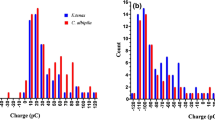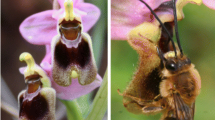Abstract
This paper reviews research on the role of electrostatic forces in pollination, both in natural and in agricultural systems. Researchers from various fields of biological studies have reported phenomena which they related to electrostatic forces. The theory of electrostatically mediated pollen transfer between insect pollinators and the flowers they visit is described, including recent studies which confirmed that the accumulated charges on airborne honey bees are sufficient for non-contact pollen detachment by electrostatic forces (i.e., electrostatic pollination). The most important morphological features in flower adaptiveness to electrostatic pollination were determined by means of two theoretical models of a flower exposed to an approaching charged cloud of pollen; they are style length and flower opening. Supplementary pollination by using electrostatic techniques is reported, and its possible importance in modern agriculture is discussed.
Similar content being viewed by others
References
Banerjee S., Law S. E. (1988) Characterization of chargeability of biological particulates by triboelectrification. IEEE Transactions on Industry Applications 34: 1201–1205.
Banerjee S., Law S. E. (1996) Electrostatic induction charging of pollen suspensions. IEEE/IAS Conference (in press).
Bechar A. (1996) Pollen deposition in electrostatic field. MSc thesis. The Faculty of Agricultural Engineering, The Technion — Israel Institute of Technology. (in Hebrew).
Bechar A., Shmulevich I., Eisikowitch D., Vaknin Y., Ronen B., Gan-Mor S. (1999) Simulation and testing of an electrostatic pollination system. Transactions of the ASAE 42(6): 1511–1516.
Bright A. W., Corbett R. P., Hughes J. F. (1978) Electrostatics — Electrostatic Engineering Design Guide no. 30. Oxford University Press, Oxford.
Buchmann S. L. (1983) Buzz pollination in angiosperms. In: Jones C. E., Little R. J. (eds.) Handbook of Experimental Pollination Biology. Scientific and Academic Editions, New York, pp. 73–113.
Buchmann S. L., Hurley J. P. (1978) A biophysical model for buzz pollination in angiosperms. Journal of Theoretical Biology 72: 639–657.
Chaloner W. G. (1986) Electrostatic forces in insect pollination and their significance in exine ornament. In: Blackmore S., Ferguson I. K. (eds.) Pollen and Spores: Form and Function. The Linnean Society of London, London, pp. 103–108.
Corbet S. A., Beament L., Eisikowitch D. (1982) Are electrostatic forces involved in pollen transfer? Plant, Cell and Environment 5: 125–129.
Dai Y., Law S. E. (1995) Modeling the transient electric field produced by a charged pollen cloud entering a flower. IEEE/IAS Conference 2: 1395–1402. ISBN 0-7803-3008-0.
Eisikowitch D. (1981) Some aspects of pollination of oil-seed rape (Brassica napus L.). Journal of Agricultural Science, Cambridge 96: 321–326.
Endress P. K. (1997) Relationships between floral organization, architecture, and pollination mode inDillenia (Dilleniaceae). Plant Syst. Evol. 206: 99–118.
Erickson E. H. (1975) Surface electric potential on worker honey bees leaving and entering the hive. Journal of Agricultural Research 14: 141–147.
Erickson E. H., Buchmann S. L. (1983) Electrostatics and pollination. In: Jones C. E., Little R. J. (eds.) Handbook of Experimental Pollination Biology. Scientific and Academic Editions, New York, pp. 173–184.
Free J. B. (1993) Insect Pollination of Crops. Academic Press Limited, London, pp. 68, 156.
Gan-Mor S., Schwartz Y., Bechar A., Eisikowitch D., Manor G. (1995) Relevance of electrostatic forces in natural and artificial pollination. Canadian Agricultural Engineering 37: 189–194.
Hardin G. B. (1976) Better charge, better pollination. Agricultural Research, USA 25: 15.
Honig B., Nicholls A. (1995) Classical electrostatics in biology and chemistry. Science 268: 1144–1149.
Hopping M. E., Jerram E. M. (1980a) Supplementary pollination of tree fruits. I. Development of suspension media. New Zealand Journal of Agricultural Research 23: 517–521.
Hopping M. E., Jerram E. M. (1980b) Supplementary pollination of tree fruits. II. Field trials on kiwifruit and Japanese plums. New Zealand Journal of Agricultural Research 23: 517–521.
Ish-Am G., Eisikowitch D. (1993) The behaviour of honey bees (Apis mellifera) visiting avocado (Persea americana) flowers and their contribution to its pollination. Journal of Apicultural Research 32: 175–186.
Law S. E. (1975) Electrostatic induction instrumentation for tracking and charge measurement of airborne agricultural particulates. Transactions of the ASAE 18: 40–45.
Law S. E. (1989) Electrical interactions occurring at electrostatic spraying targets. Journal of Electrostatics 23: 145–156.
Law S. E., Cooper S. C. (1989) Target grounding requirements for electrostatic deposition of pesticide sprays. Transactions of the ASAE 32: 1169–1172.
Law S. E., Banerjee S., Wetzstein H. Y., Eisikowitch D. (1996) Electrostatic application of pollen sprays: effects of charging field intensity and aerodynamic shear upon deposition and germinability. IEEE/IAS Conference 4: 1940–1948. ISBN 0-7803-3544-9.
Legge A. P. (1975) Artificial supplementary pollination of European fruit crops. Ph.D. thesis, University of Bath.
McGranahan G. H., Voyiatzis D. G., Catlin P. B., Polito V. S. (1994) High pollen loads can cause pistillate flower abscission in walnut. Journal of the American Society of Horticultural Science 119: 505–509.
McGregor S. E. (1976) Insect Pollination of Cultivated Crop Plants. U.S.D.A. Agriculture Handbook No. 496. pp. 75–79, 81–88, 135–137.
Maw M. G. (1962) Some biological effects of atmospheric electricity. Proceedings of the Entomological Society of Ontario 92: 33–37.
Niklas K. J. (1985) The aerodynamics of wind pollination. Botanical Review 51: 328–386.
Niklas K. J., Buchmann S. L. (1985) Aerodynamics of wind pollination inSimmondsia chinensis (Link) Schneider. American Journal of Botany 72: 530–539.
Niklas K. J., Buchmann S. L. (1988) Aerobiology and pollen capture of orchard-grownPistacia vera (Anacardiaceae). American Journal of Botany 75: 1813–1829.
Niklas K. J., Buchmann S. L., Kerchner V. (1986) Aerodynamics ofEphedra trifurca: I. Pollen grain velocity fields around stems bearing ovules. American Journal of Botany 73: 966–979.
Oltman D. (1997) Gaining an edge — supplementing the amount of pollen normally distributed in an orchard is proving to be an effective form of crop insurance for many commodities. California Farmer. April, pp. 8–9, 18, 47, 76.
Philippe G., Baldet P. (1997) Electrostatic dusting: an efficient technique of pollination in larch. Annales des Sciences Forestieres 54: 301–310.
Schroeder C. A. (1995) Electrostatic effects with avocado pollen. California Avocado Society Year Book 79: 201–204.
Schwartz Y. (1991) Pollen harvesting by electrostatic and aerodynamic techniques. MSc thesis. The Faculty of Agricultural Engineering, The Technion — Israel Institute of Technology (in Hebrew).
Shivanna K. R., Sawhney V. K. (1997) Pollen biology and pollen biotechnology: an introduction. In: Shivanna K. R., Sawhney V. K. (eds.) Pollen Biotechnology for Crop Production and Improvement. Cambridge University Press, Cambridge, pp. 1–12.
Stanley R. G., Linskens H. F. (1974) Pollen: Biology, Biochemistry and Management. Springer, New York, pp. 36.
Thorp R. W. (1979) Structural, behavioral, and physiological adaptations of bees (Apoidea) for collecting pollen. Annals of the Missouri Botanic Garden 66: 788–812.
Vaknin Y. (1999) The use of electrostatic methods in pollination of cultivated plants. Ph.D. thesis. George S. Wise Faculty of Life Sciences, Department of Plant Sciences, Tel-Aviv University (in Hebrew).
Vaknin Y., Eisikowitch D. (2000) Effects of shortterm storage on germinability of pistachio pollen. Plant Breeding (In print).
Vaknin Y., Gan-Mor S., Bechar A., Ronen B., Eisikowitch D. (1999) Effects of desiccation and dilution on germinability of almond pollen. Journal of Horticultural Science & Biotechnology 74: 321–327.
Vaknin Y., Gan-Mor S., Bechar A., Ronen B., Eisikowitch D. (2000) Electrostatic pollination of almond (amygdalus communis L. Rosaceae). (In preparation).
Vaknin Y., Gan-Mor S., Bechar A., Ronen B., Eisikowitch D. (2000) Electrostatic pollination of pistachio (Pistacia vera L. Anacardiaceae). (In preparation).
Warnke U. (1977) Information transmission by means of electrical biofields. Proceedings of the Symposium on Electromagnetic Bio-Information of Marburg, pp. 55–79.
Whitehead D. R. (1969) Wind pollination in the angiosperms: evolutionary and environmental considerations. Evolution 23: 28–35.
Williams R. R., Legge A. P. (1979) Pollen application by mechanical dusting in English apple orchards. Journal of Horticultural Science 54: 67–74.
Woittiez R. D., Willemse M. T. M. (1979) Sticking of pollen on stigmas: the factors and a model. Phytomorphology 29: 57–63.
Yes'kov Y. K., Sapozhnikov A. M. (1976) Mechanisms of generation and perception of electric fields by honey bees. Biophysics 21: 1124–1130.
Author information
Authors and Affiliations
Rights and permissions
About this article
Cite this article
Vaknin, Y., Gan-Mor, S., Bechar, A. et al. The role of electrostatic forces in pollination. Pl Syst Evol 222, 133–142 (2000). https://doi.org/10.1007/BF00984099
Received:
Accepted:
Issue Date:
DOI: https://doi.org/10.1007/BF00984099




